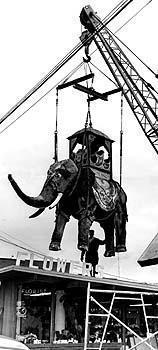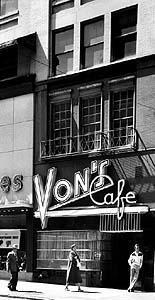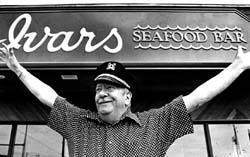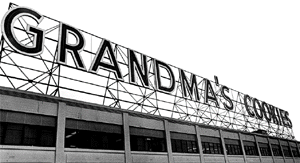By Sharon Boswell
and Lorraine McConaghy
Special to The Times
 Seattle retailers didn't just think big, they thought gigantic when it came
to advertising their businesses. This local landmark, an 1,800-pound elephant, is lifted from the roof
of an Aurora Avenue florist in 1964, to be moved to the shopıs new building next door.
Seattle retailers didn't just think big, they thought gigantic when it came
to advertising their businesses. This local landmark, an 1,800-pound elephant, is lifted from the roof
of an Aurora Avenue florist in 1964, to be moved to the shopıs new building next door.
Photo Credit: Bruce McKim / Seattle Times.
IN OCTOBER 1962, A SMALL PARAGRAPH IN THE SEATTLE TIMES BUSINESS SECTION ANNOUNCED THE
OPENING OF A NEW DRIVE-IN offering 15-cent hamburgers and only nine other menu items. The
restaurant was Seattle's first McDonald's.
The national chain came late to the Northwest; it already operated in 42 other states. Yet by the time company chairman Ray Kroc visited Seattle in 1967, six more McDonald's fed the city's budget-conscious families.
In the "Soaring '60s," the concept of franchising -- adapting a corporate idea to the nationwide market -- was as hot in business as miniskirts and bell bottoms were in fashion. By late in the decade, about $80 billion or
10 percent of the yearly gross national product came from franchises. Seattle's suburban growth made it a prime target for these growing chains.
A few of the city's established retailers tried to capitalize on the franchise frenzy by expanding their own successful business concepts. Others, regarding the new competition as a threat, turned to increased advertising and wild marketing ploys to attract customers.
But Seattle already had a long tradition of quirky hometown "institutions" -- businesses that commanded a loyal following because of their unusual style or unabashed self-promotion. Next to Mount Rainier, many of the region's most recognizable landmarks were manmade monuments to madcap marketing schemes -- everything from pink elephants and metal teepees to, of course, giant space needles.
Local restaurants led the way in creating unique identities. In Seattle's early, bawdier days, it was less the decor than the price of a drink that drew customers. As Seattle became a family town, good meals at low cost were a prerequisite, but atmosphere also helped bring in business.
 At right, Von's (originally known as Rippe's), became a Seattle institution,
offering a wide menu and 24-hour service in an elegant atmosphere. Photo Credit: Seattle Times.
At right, Von's (originally known as Rippe's), became a Seattle institution,
offering a wide menu and 24-hour service in an elegant atmosphere. Photo Credit: Seattle Times.
RIPPE'S CAFE, STARTED IN 1910, WAS ONE OF SEATTLE'S EARLIEST UPSCALE "INSTITUTIONS,"
best known for its mahogany-and-brass booths and 24-hour service. For decades Rippe's,
which later became Von's, attracted many of the city's leading citizens as well as visiting celebrities --
from Calvin Coolidge to Jean Harlow. Von's tony appeal fell victim to the fast-food trend of the '60s,
though another incarnation opened years later.
Most of Seattle's other popular eateries were less fashionable and more eccentric. The Dog House, founded in 1934, patterned itself after Hollywood's Brown Derby and covered its walls with all sorts of canine paraphernalia, including pictures of dogs instead of movie stars. It catered to hungry diners from all walks of life, offering steaks ("tenderness not guaranteed") and sandwiches with names like "the Mutt" and "the Pooch." Bob Murray, the first owner, also promoted rodeos, wrestling and even the city's first (and last) bullfight.
Probably the city's best-known and most flamboyant restaurateur, however, was Ivar Haglund. He began his career operating a small aquarium on Seattle's waterfront but soon branched into the food business. An admitted "publicity hound," Haglund was also a singer-songwriter whose corny ballads earned him a radio program and enough money to open the first "Acres of Clams" restaurant in 1945.
Ever the showman, Ivar frequently sported a captain's uniform and used antics like an annual world-championship clam-eating contest to promote his ventures. By the early 1960s, while urging everyone to "keep clam," Ivar had built a seafood empire that included fish bars and several restaurants catering to families and the tourist trade.
 The captain of Seattle kitsch, Ivar Haglund, was a beloved local personality,
best remembered for zany promotions publicizing his seafood restaurants.
The captain of Seattle kitsch, Ivar Haglund, was a beloved local personality,
best remembered for zany promotions publicizing his seafood restaurants.
Photo Credit: Vic Condiotty / Seattle Times.
DESPITE HIS CLOWNISH PERSONA, HAGLUND WAS AN ASTUTE BUSINESSMAN. Sensitive to new eating trends,
Ivar tried his own drive-in and renovated existing restaurants. He also stepped up civic promotions,
staging a waterfront fireworks extravaganza in 1968 that became a yearly event.
Other local entrepreneurs capitalized on the fast-food craze to build their own restaurant empires. Dick's, one of the area's first drive-ins, was opened in 1954 by Warren Ghormley, Dr. "Tom" Thomas and Dick Spady, for whom it was named. Dick's offered a limited menu including shakes, fries and a 19-cent hamburger, vying for the growing teenage market against local competitors Gill's, Dag's and Burgermaster as well as Herfy's, a national chain. Dick's didn't have carhops like "the Burg," but its simple, unchanging formula caught on. Its owners followed the McDonald's example, building four more Dick's locally by 1965.
Area restaurants were not alone in battling huge national conglomerates; other Seattle retailers also developed strategies to keep their names visible and lure potential customers.
Some sought expansion possibilities. The Nordstrom family, for example, had already built a solid reputation based on quality merchandise and personal service. In the shoe business since 1901, Nordstrom branched out into the fashion-clothing business in 1963 with the purchase of another local company, Best Apparel. By decade's end, they had developed seven Nordstrom Best stores in addition to their 27 shoe outlets, and soon went public in order to finance continued growth.

Even certain signs gained a place in the hearts of area residents. Grandma's Cookies had
other bakeries outside Seattle, but their name, spanning the length of the local factory, became
an important part of the Lake Union landscape. Photo Credit: Seattle Times.
OTHERS CHOSE TO FOCUS ON LOCAL CONSUMERS, FINDING THEIR OWN SPECIAL NICHE OR MARKETING ANGLE. The Chubby
and Tubby philosophy seemed almost the reverse of Nordstrom's -- cram all the merchandise you can
into the smallest space, making every visit a virtual combat experience. The store, after all, got its start selling
World War II military surplus; by the '60s it became the chic place to shop cheap for everything from scrawny
Christmas trees to Perry Como records.
Signs and advertising gimmicks also proliferated, the bigger the better.
Elephants were a particular favorite: a huge pink one splashed himself at a downtown car wash
while a more ornate pachyderm perched on an Aurora Avenue florist shop. Seattleites had also come to
love the huge neon lettering of Grandma's Cookies atop its north Lake Union factory and the familiar face of
Sunny Jim, beaming down from the building of the local peanut-butter manufacturer.
Throughout the 1960s Seattle fought the battle of the billboard as the Golden
Arches and Colonel Sanders sought to displace hometown products. But in most cases, the local
"institutions" survived. Northwesterners valued service and quality, but they also found a place
in their hearts for outlandish kitsch.
Historians Sharon Boswell and Lorraine McConaghy teach at local universities and do research,
writing and oral history. Original newspaper graphics courtesy of the Seattle Public Library.